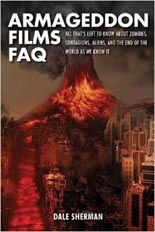
 John Kenneth Muir’s Horror Films FAQ will appeal most to those who have read his many, many books on scary movies before, yet they will gain little from it. There are better starting places for newcomers to the genre, many of whom I would bet already know more about the likes of Dracula and Frankenstein than this guide assumes.
John Kenneth Muir’s Horror Films FAQ will appeal most to those who have read his many, many books on scary movies before, yet they will gain little from it. There are better starting places for newcomers to the genre, many of whom I would bet already know more about the likes of Dracula and Frankenstein than this guide assumes.
To be fair, the Universal Monsters and their archetypes are hardly the only cinematic bad guys the book covers; also under the spotlight are aliens, animals, serial killers, zombies, ghosts, kids and ol’ Scratch himself (aka Satan).
Later in the book, and this is where Muir excels, he turns more toward trends than creatures to give brief rundowns of torture porn, Asian remakes and adaptations of video games and Stephen King novels. There’s even a chapter on TV shows, despite the fact they’re not films and that Muir already has written an entire book on the subject (2001’s cost-prohibitive Terror Television).
In his introduction to Horror Films FAQ, he writes, “Countenancing a good scary movie is not just fun, it’s actually cathartic.” I’d be inclined to agree if I knew exactly what he meant; “countenance” means “sanction,” but that doesn’t quite fit the line. No big deal — it’s just the first of many odd choices, opinions and phrases that pop up throughout, whether classifying Lovely Molly as found footage (only in part, but not overwhelmingly) or deeming the TV series Dexter and The Walking Dead as soap operas.
 With only a little overlap, worth exploring more is Dale Sherman’s Armageddon Films FAQ. Because “armageddon” is not a genre as “horror” is, the canvas is comparatively blank, allowing for surprise.
With only a little overlap, worth exploring more is Dale Sherman’s Armageddon Films FAQ. Because “armageddon” is not a genre as “horror” is, the canvas is comparatively blank, allowing for surprise.
Yes, Sherman delves into the expected disaster films and/or nearly the entire CV of Roland Emmerich, but also zombie uprisings, ape planets, Martian invasions, killer viruses and body snatchers. His scope is so wide, some titles are included that might not have come to my mind for “end of the world” viewing even after hours of thinking: Fight Club, Judge Dredd (the Stallone one) and Kids in the Hall: Brain Candy.
As with Muir’s book, Sherman also includes a chapter dedicated to examples on the tube, plus adds one on music videos. Again, these aren’t films, but I guess whenever civilization does collapse and we’re without electricity, we’ll all need more to read, right? —Rod Lott
